The Smart Doorbell Market is estimated to be valued at USD 6.2 billion in 2025 and is projected to reach USD 110.5 billion by 2035, registering a compound annual growth rate (CAGR) of 33.4% over the forecast period.
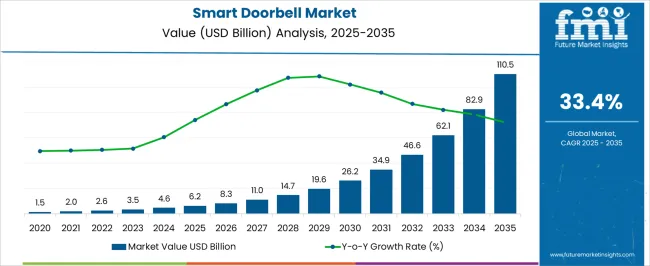
| Metric | Value |
|---|---|
| Smart Doorbell Market Estimated Value in (2025 E) | USD 6.2 billion |
| Smart Doorbell Market Forecast Value in (2035 F) | USD 110.5 billion |
| Forecast CAGR (2025 to 2035) | 33.4% |
The Smart Doorbell market is experiencing rapid growth driven by increasing consumer demand for intelligent home security and convenience solutions. The current market environment is characterized by the convergence of advanced hardware, network connectivity, and software-enabled features such as video streaming, motion detection, and remote access. Residential adoption is being fueled by the need for enhanced safety, easy visitor management, and integration with broader smart home ecosystems.
Technological advancements in wireless communication, battery efficiency, and cloud storage are supporting seamless deployments and improving user experience. The growth outlook for the market is underpinned by rising awareness about home security, the proliferation of connected devices, and the increasing affordability of smart doorbell solutions.
Furthermore, rising urbanization and the increasing number of multi-dwelling units are generating strong demand for scalable and easy-to-install solutions As homes continue to embrace automation and digital monitoring, the Smart Doorbell market is poised to expand, offering products that combine hardware reliability with software-driven intelligence to meet evolving consumer expectations.
The smart doorbell market is segmented by product type, end users, component, sales channel, and geographic regions. By product type, smart doorbell market is divided into Wireless Smart Doorbells and Wired Smart Doorbells. In terms of end users, smart doorbell market is classified into Residential, Corporate, and Industrial. Based on component, smart doorbell market is segmented into Hardware, Software, and Service. By sales channel, smart doorbell market is segmented into Online Traders/E-Commerce and Organized Retailers. Regionally, the smart doorbell industry is classified into North America, Latin America, Western Europe, Eastern Europe, Balkan & Baltic Countries, Russia & Belarus, Central Asia, East Asia, South Asia & Pacific, and the Middle East & Africa.
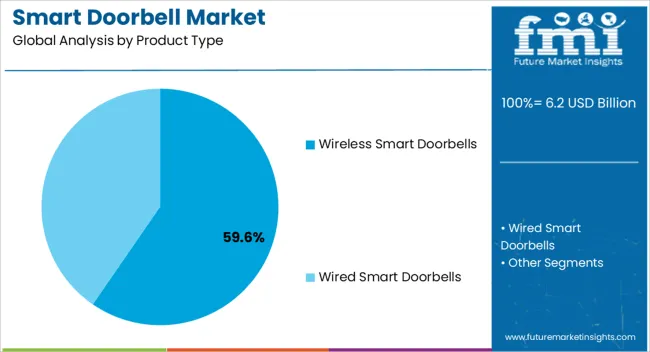
The Wireless Smart Doorbells segment is projected to hold 59.60% of the Smart Doorbell market revenue share in 2025, establishing it as the leading product type. This leadership position is being attributed to the convenience and flexibility offered by wireless technology, which eliminates the need for complex wiring and enables easy installation across diverse residential properties.
The growth of this segment has been supported by the increasing preference for battery-powered solutions that provide mobility and seamless integration with smartphones and smart home systems. Wireless smart doorbells are being favored for their remote monitoring capabilities, high-definition video streaming, and compatibility with cloud services that allow for secure storage and real-time notifications.
As more households adopt connected home solutions, demand for devices that are both user-friendly and technologically advanced has surged The ability to upgrade firmware remotely and incorporate new software features without physical changes to hardware has further reinforced the dominance of wireless doorbells in the market, with future growth expected to continue as smart home penetration increases globally.
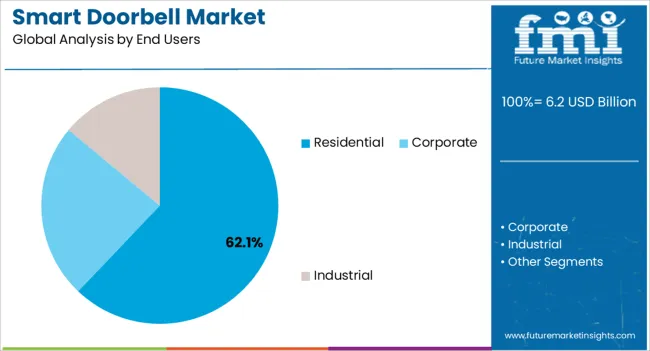
The Residential end-use segment is expected to account for 62.10% of the Smart Doorbell market revenue share in 2025, making it the largest application area. Growth in this segment is being driven by heightened consumer awareness of home security, the need for monitoring visitors, and convenience in daily household management.
Residential adoption has been supported by the integration of smart doorbells with broader home automation ecosystems, enabling remote access, notifications, and video monitoring from anywhere. The increased focus on safety for families, pets, and property, coupled with the accessibility of affordable devices, has accelerated adoption across single-family homes and multi-unit residential complexes.
Ease of installation and wireless connectivity have allowed rapid deployment in varied residential settings, while the flexibility to upgrade software has made these devices adaptable to evolving security and smart home requirements As digital home solutions continue to gain traction, the residential segment is projected to sustain its leading position in the Smart Doorbell market, supported by growing interest in connected, intelligent living spaces.
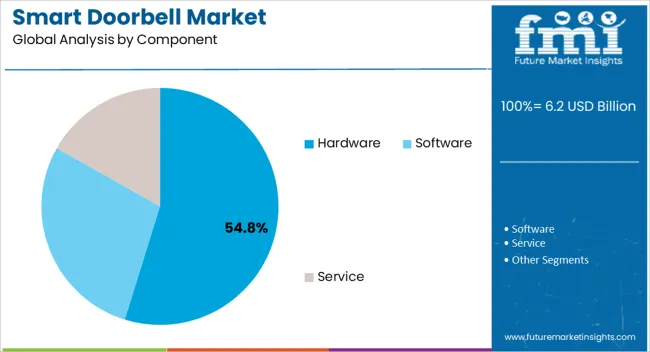
The Hardware component segment is anticipated to hold 54.80% of the Smart Doorbell market revenue share in 2025, establishing it as the primary contributor among components. The growth of this segment has been driven by the demand for reliable and durable physical components such as cameras, sensors, chimes, and enclosures that form the backbone of high-performing smart doorbells.
Hardware reliability is essential to ensure consistent performance, particularly for devices operating continuously in residential environments and exposed to external elements. The expansion of this segment is also being supported by advancements in high-definition cameras, motion detection sensors, and energy-efficient power solutions, which enhance the overall functionality and user experience.
The ability to pair robust hardware with software-driven features allows manufacturers to offer scalable solutions that can adapt to evolving security requirements without replacing physical components Continued innovation in durable and efficient hardware design, along with the increasing integration of these devices into connected home systems, is expected to reinforce the dominance of the hardware component segment in the Smart Doorbell market.
An internet-enabled smart doorbell sends a notification to the smartphone of the owner when a visitor presses the button. Smart doorbells are compatible with Android or iOS-based dedicated smartphone applications. Some smart doorbells have integrated motion sensors that detect the presence of visitors once they reach the doorstep. The motion sensors also enable the smart doorbell to snap a picture of the visitor. Once installed, a smart doorbell allows the home owner to view and converse with the visitor via a built-in microphone and high definition camera. When used with a smart lock, the smartphone application connecting the smart doorbell and the home owner allows access to the visitor remotely. The display of smart doorbell can be customized according to the home owner’s requirements.
Special information or messages, such as the house number or a ‘Do Not Disturb’ note, can be displayed on the smart doorbell hardware. Manufacturers are offering smart doorbell solutions with built-in infrared LED integration, which allows the smart doorbell camera to capture images at night. Currently, manufacturers are offering smart doorbell solutions mostly for the commercial and industrial sectors, and residential sector has also witnessed increasing adoption.
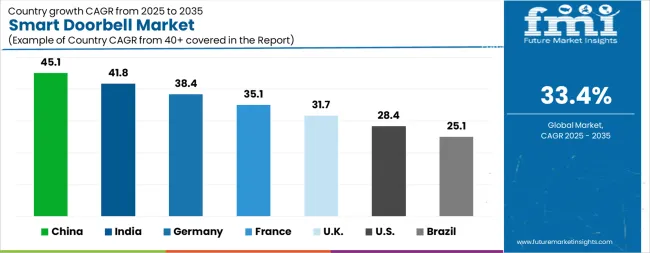
| Country | CAGR |
|---|---|
| China | 45.1% |
| India | 41.8% |
| Germany | 38.4% |
| France | 35.1% |
| UK | 31.7% |
| USA | 28.4% |
| Brazil | 25.1% |
The Smart Doorbell Market is expected to register a CAGR of 33.4% during the forecast period, exhibiting varied country level momentum. China leads with the highest CAGR of 45.1%, followed by India at 41.8%. Developed markets such as Germany, France, and the UK continue to expand steadily, while the USA is likely to grow at consistent rates. Brazil posts the lowest CAGR at 25.1%, yet still underscores a broadly positive trajectory for the global Smart Doorbell Market. In 2024, Germany held a dominant revenue in the Western Europe market and is expected to grow with a CAGR of 38.4%. The USA Smart Doorbell Market is estimated to be valued at USD 2.2 billion in 2025 and is anticipated to reach a valuation of USD 26.7 billion by 2035. Sales are projected to rise at a CAGR of 28.4% over the forecast period between 2025 and 2035. While Japan and South Korea markets are estimated to be valued at USD 328.2 million and USD 192.7 million respectively in 2025.
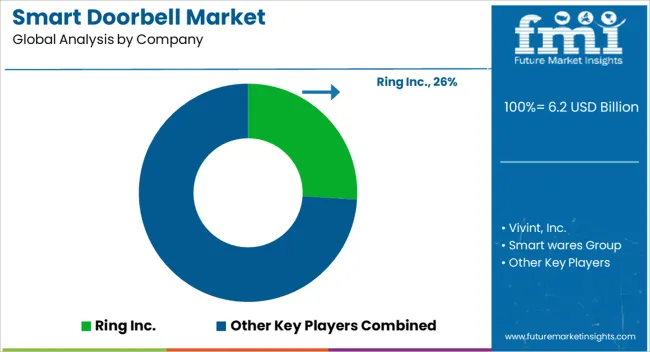
| Item | Value |
|---|---|
| Quantitative Units | USD 6.2 Billion |
| Product Type | Wireless Smart Doorbells and Wired Smart Doorbells |
| End Users | Residential, Corporate, and Industrial |
| Component | Hardware, Software, and Service |
| Sales Channel | Online Traders/E-Commerce and Organized Retailers |
| Regions Covered | North America, Europe, Asia-Pacific, Latin America, Middle East & Africa |
| Country Covered | United States, Canada, Germany, France, United Kingdom, China, Japan, India, Brazil, South Africa |
| Key Companies Profiled | Ring Inc., Vivint, Inc., Smart wares Group, Intelligent Technology Co. Ltd., Sky Bell Technologies Inc., Aeotec Technology (Shenzhen) Co. Ltd., Arlo Technologies Inc., August Home Inc., Eques Inc., and iseeBell Inc. |
The global smart doorbell market is estimated to be valued at USD 6.2 billion in 2025.
The market size for the smart doorbell market is projected to reach USD 110.5 billion by 2035.
The smart doorbell market is expected to grow at a 33.4% CAGR between 2025 and 2035.
The key product types in smart doorbell market are wireless smart doorbells and wired smart doorbells.
In terms of end users, residential segment to command 62.1% share in the smart doorbell market in 2025.






Our Research Products

The "Full Research Suite" delivers actionable market intel, deep dives on markets or technologies, so clients act faster, cut risk, and unlock growth.

The Leaderboard benchmarks and ranks top vendors, classifying them as Established Leaders, Leading Challengers, or Disruptors & Challengers.

Locates where complements amplify value and substitutes erode it, forecasting net impact by horizon

We deliver granular, decision-grade intel: market sizing, 5-year forecasts, pricing, adoption, usage, revenue, and operational KPIs—plus competitor tracking, regulation, and value chains—across 60 countries broadly.

Spot the shifts before they hit your P&L. We track inflection points, adoption curves, pricing moves, and ecosystem plays to show where demand is heading, why it is changing, and what to do next across high-growth markets and disruptive tech

Real-time reads of user behavior. We track shifting priorities, perceptions of today’s and next-gen services, and provider experience, then pace how fast tech moves from trial to adoption, blending buyer, consumer, and channel inputs with social signals (#WhySwitch, #UX).

Partner with our analyst team to build a custom report designed around your business priorities. From analysing market trends to assessing competitors or crafting bespoke datasets, we tailor insights to your needs.
Supplier Intelligence
Discovery & Profiling
Capacity & Footprint
Performance & Risk
Compliance & Governance
Commercial Readiness
Who Supplies Whom
Scorecards & Shortlists
Playbooks & Docs
Category Intelligence
Definition & Scope
Demand & Use Cases
Cost Drivers
Market Structure
Supply Chain Map
Trade & Policy
Operating Norms
Deliverables
Buyer Intelligence
Account Basics
Spend & Scope
Procurement Model
Vendor Requirements
Terms & Policies
Entry Strategy
Pain Points & Triggers
Outputs
Pricing Analysis
Benchmarks
Trends
Should-Cost
Indexation
Landed Cost
Commercial Terms
Deliverables
Brand Analysis
Positioning & Value Prop
Share & Presence
Customer Evidence
Go-to-Market
Digital & Reputation
Compliance & Trust
KPIs & Gaps
Outputs
Full Research Suite comprises of:
Market outlook & trends analysis
Interviews & case studies
Strategic recommendations
Vendor profiles & capabilities analysis
5-year forecasts
8 regions and 60+ country-level data splits
Market segment data splits
12 months of continuous data updates
DELIVERED AS:
PDF EXCEL ONLINE
Smart School Bus Platform Market Size and Share Forecast Outlook 2025 to 2035
Smart Home Wireless Smoke Detector Market Size and Share Forecast Outlook 2025 to 2035
Smart Bus Platform Market Size and Share Forecast Outlook 2025 to 2035
Smart Vision Processing Chips Market Size and Share Forecast Outlook 2025 to 2035
Smart Touch Screen Scale Market Size and Share Forecast Outlook 2025 to 2035
Smart Magnetic Drive Conveyor System Market Size and Share Forecast Outlook 2025 to 2035
Smart Wheelchair market Size and Share Forecast Outlook 2025 to 2035
Smart Mining Technologies Market Size and Share Forecast Outlook 2025 to 2035
Smart Parking Market Size and Share Forecast Outlook 2025 to 2035
Smart Digital Valve Positioner Market Forecast and Outlook 2025 to 2035
Smart Card IC Market Size and Share Forecast Outlook 2025 to 2035
Smart-Tag Inlay Inserters Market Analysis - Size and Share Forecast Outlook 2025 to 2035
Smart TV Market Forecast and Outlook 2025 to 2035
Smart/AI Toy Market Size and Share Forecast Outlook 2025 to 2035
Smart Locks Market Size and Share Forecast Outlook 2025 to 2035
Smart Sprinkler Controller Market Size and Share Forecast Outlook 2025 to 2035
Smart Indoor Gardening System Market Size and Share Forecast Outlook 2025 to 2035
Smart Building Delivery Robot Market Size and Share Forecast Outlook 2025 to 2035
Smart Watch Market Size and Share Forecast Outlook 2025 to 2035
Smart Label Market Size and Share Forecast Outlook 2025 to 2035

Thank you!
You will receive an email from our Business Development Manager. Please be sure to check your SPAM/JUNK folder too.
Chat With
MaRIA